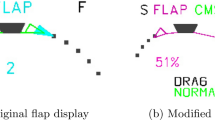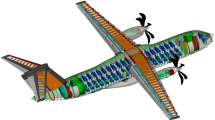Abstract
This paper describes a method to investigate the benefits of a continuously moving high-lift system for departure. During take-off and climb, a typical airliner accelerates. The slat/flap setting is configured stepwise after the acceleration altitude is reached. Thus, most of the time the configuration is not in its aerodynamic optimum. The continuous moving system adapts the slat/flap setting based on the airspeed and aircraft mass and enables the aircraft to fly with the aerodynamic optimal configuration. The performance is analysed using a flight simulation of a typical short-to-mid-range airliner and under variation of a standard take-off procedure. The tool continuous flap assessment (CoFA), developed in the project Con.Move, is capable of analysing performance benefits of continuous slat/flap settings. This paper describes and demonstrates the method by showing the influences of continuously moving high-lift systems on flight path, energy balance, and fuel consumption for different control laws for the retraction of the slats/flaps using a first version of the tool CoFA. It gives an overview of the simulation environment and the developed modules for the tool, describes the comparison take-off procedure, and shows the resulting flight paths for the different control laws.


























Similar content being viewed by others
Abbreviations
- \(C_{\text{D}}\) :
-
Drag coefficient
- \(C_{\text{L}}\) :
-
Lift coefficient
- \(c_{\text {c/eq/n/p}}\) :
-
Config value (continuous/equivalent/next/previous)
- \(\delta _{\text {fl,sl}}\) :
-
Deflection of flap or slat
- F :
-
Wing area
- g :
-
Standard gravitational acceleration
- \(\gamma\) :
-
Flight path angle
- \(H_{\text {accel}}\) :
-
Acceleration altitude
- \(H_{\text {AGL}}\) :
-
Altitude above ground level
- \(H_{\text {E}}\) :
-
Energy height
- m :
-
Mass
- \(\rho\) :
-
Density
- S :
-
Horizontal distance from start point
- \(\theta _{\text {cmd}}\) :
-
Commanded pitch angle
- \(V_{\text {1,R,LOF}}\) :
-
Take-off speeds (decision, rotation, lift-off)
- \(V_{\text {act}}\) :
-
Actual airspeed
- \(V_{\text {dec,p/n}}\) :
-
Decision speed previous/next
- \(V_{\text {IAS}}\) :
-
Indicated airspeed
- \(V_{\text {LS,std}}\) :
-
Speed laws (configuration change), lowest selectable
- \(V_{\text {Drag,m.}}\) :
-
Speed laws (config. change), minimal drag
- \(V_{\text {GD}}\) :
-
Speed laws (config. change), green dot
- \(V_{\text {Paero,m.}}\) :
-
Speed laws (config. change), min. aero. power loss
- AGL:
-
Above ground level
- CoFA:
-
Tool for continuous flap assessment
- ModATA:
-
Modified ATA—take-off procedure
- MLM:
-
Maximum landing mass
- (M)TOM:
-
(Maximum) take-off mass
- PM:
-
Pilot model
- TOGA:
-
Take-off and go around thrust
References
European Aviation Safety Agency: certification specifications and acceptable means of compliance for large aeroplanes CS-25/Amendment 20, Germany (2017)
König, R., Macke, O., Kreth, S.: Design and evaluation of short-term realizable new noise abatement flight procedures. INTER-NOISE, Honolulu (2006)
Krishnamurthy, V., Hamann, A., Luckner, R.: Automatisierte Prozesskette zur flugmechanischen Bewertung von Parameteränderungen im Rahmen des modellbasierten Flugzeugvorentwurfs, presented at DLRK, Rostock (2015). URN:101:1-201601222820
Krishnamurthy, V., Luckner, R.: Flight mechanical modelling considering flexibility and flight control functions in preliminary aircraft design. In: Presented at AIAA Modeling and Simulation Technologies Conference, Denver, Colorado (2017). https://doi.org/10.2514/6.2017-4332
Lauterbach, M., Luckner, R.: Vergleich verschiedener Regelstrategien für die stufenlose Verstellung der Hinterkantenklappen im Landeanflug. In: Presented at DLRK, Bremen, Germany (2011). Document ID 241268
Köthe, A.: Analyse und Bewertung der Startleistung eines Luftfahrzeugs mit kontinuierlich verstellbaren Hinterkantenklappen. In: Presented at DLRK, Hamburg, Germany (2010). Document ID 161502
Szodruch, J.: The influence of camber variation on the aerodynamics of civil transport aircraft. In: AIAA 23rd Aerospace Science Meeting, Reno. Nevada (1985). https://doi.org/10.2514/6.1985-353
Franke, D.: Investigation on continuously deflectable high-lift devices for a 3D high-lift configuration. In: 33rd AIAA Applied Aerodynamics Conference, Dallas. Texas (2015). https://doi.org/10.2514/6.2015-2258
Strüber, H.: The aerodynamic design of the A350 XWB-900 high lift system. In: Presented at 29th congress of the international council of the aeronautical science. St. Petersburg, Russia (2014)
Amelsberg, S.: The CREDOS project–pilot model for wake vortex encounter simulations for take-off and departure, project report CREDOS D3–6. TU Berlin, Berlin (2009)
Acknowledgements
The work presented in this paper was funded by the German Federal Ministry for Economic Affairs and Energy (BMWi) due to resolution of the German Federal Parliament within the scope of the LuFo V/2 compound project CON.MOVE and TU Berlin’s subproject AM-Move (Grant number 20A1505D). The authors gratefully acknowledge this support.
Author information
Authors and Affiliations
Corresponding author
Rights and permissions
About this article
Cite this article
Stukenborg, P., Luckner, R. Evaluating the influence of continuous flap settings on the take-off performance of an airliner using flight simulation. CEAS Aeronaut J 9, 671–681 (2018). https://doi.org/10.1007/s13272-018-0315-2
Received:
Revised:
Accepted:
Published:
Issue Date:
DOI: https://doi.org/10.1007/s13272-018-0315-2




